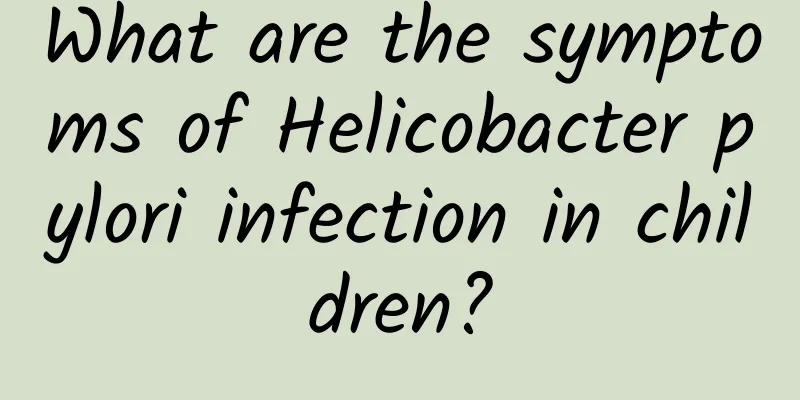What are the symptoms of Helicobacter pylori infection in children?

|
Helicobacter pylori is a common pathogen that often lives in the human stomach and intestines, causing chronic gastritis, atrophic gastritis leading to gastric ulcers and other diseases. Helicobacter pylori can be transmitted through certain channels. If parents have this bacteria, their children are likely to be infected, causing digestive tract ulcers, chronic gastritis, etc., which is quite harmful to their growth and development. 1. Children with chronic gastritis: There are different degrees of indigestion symptoms, the severity of the clinical manifestations varies, and the course of the disease is prolonged. The main symptom is recurrent abdominal pain with no obvious regularity that usually worsens after eating. The exact location of pain is usually around the navel. Young children may only experience restlessness and changes in normal eating behavior when experiencing abdominal pain, while older children may experience symptoms similar to those of adults, often complaining of upper abdominal pain followed by belching, early satiety, nausea, upper abdominal discomfort, and acid reflux. Eating hard, cold, spicy food or catching a cold or when the temperature drops may trigger or aggravate the symptoms. Some children may have loss of appetite, fatigue, weight loss and dizziness, and those with gastric erosion may have black stools. The physical signs are mostly not obvious, and the tenderness may be located in the upper and middle abdomen or around the navel, covering a wide range. 2. Peptic ulcer in children: The clinical manifestations vary greatly, and the symptoms vary greatly at different ages. (1) Neonatal period: The main features are sudden upper gastrointestinal bleeding or perforation, which often starts acutely and is easily misdiagnosed with symptoms such as vomiting blood, bloody stools, abdominal distension, and peritonitis. Most cases in this period are acute stress ulcers with a high mortality rate. The disease most often occurs within 24 to 48 hours after birth. (2) Infancy: Children in this period often have an acute onset of illness, irritability, poor appetite, sudden vomiting of blood, and black stools. In the early stages, they may also have loss of appetite, repeated vomiting and abdominal pain, and delayed growth and development. (3) Preschool period: During this period, abdominal pain symptoms are obvious, mostly located around the umbilicus and occurring intermittently. The relationship with diet is unclear. Nausea, vomiting, acid reflux, anemia, and upper gastrointestinal bleeding are also common. (4) School age: As age increases, clinical manifestations become similar to those of adults, with symptoms mainly including upper abdominal pain and periumbilical pain, sometimes with night pain, or acid reflux, belching, or chronic anemia. A few people present with painless black stools, fainting, or even shock. complication Children often become emaciated, suffer from malnutrition and anemia; they may also develop peptic ulcers, gastrointestinal bleeding, and in a few cases, atrophic gastritis and gastric cancer. 1. Bleeding: Bleeding complications can sometimes be the first symptom of ulcer without any prodromal manifestations. Vomiting blood is generally seen in gastric ulcers, and the vomitus is coffee-like, while black stools are more common in duodenal ulcers. When the amount of bleeding is large, any type of ulcer may present with vomiting blood and black stools at the same time. In children, bloody gastric drainage often indicates gastric bleeding, but if the drainage is negative, the possibility of duodenal ulcer with bleeding cannot be ruled out (because blood can flow back into the stomach without passing through the pylorus). 2. Perforation: Perforation is much less common than bleeding. Ulcer perforation often occurs suddenly and may not have any precursor symptoms. A small number of children without a history of ulcers may present with perforation complications as the first symptom, and surgery may confirm that they have duodenal ulcer with perforation. Stress gastric ulcer perforation can also be seen in the early neonatal period, causing abdominal pain and distension. |
<<: Can I have children if I have Hashimoto's disease?
>>: What causes constipation in children?
Recommend
The difference between cervical mucus plug and spotting
When a certain amount of cervical mucus blockage ...
Liver function two and a half
The two-pair-and-a-half test of liver function ma...
Is stroke a cerebral infarction?
When people reach middle age or old age, the inci...
Why do I always have allergies? How to give first aid
People with allergic constitutions are extremely ...
White spots on the neck
The neck is a very sensitive part of the human bo...
What are the foods that regulate the spleen and stomach? These four foods can be eaten regularly
Poor spleen and stomach often make people unable ...
Can Guiling Gao remove acne?
Guilinggao has a more obvious effect, which is th...
Is Chinese herbal whitening and anti-freckle cream really effective?
With the development of modern technology, more a...
4 tips to remove skin scars
Whether it is children or adults, it is inevitabl...
The process of doing an MRI of the knee
When you do an MRI on your knees, it is mainly to...
Is the smell under the armpit body odor?
Body odor should not be unfamiliar to everyone. T...
What medicine should I take for nipple pain
Many women experience nipple pain for no apparent...
Premonitions of myocardial infarction
Myocardial infarction is a very dangerous acute b...
What are some quick ways to lower blood sugar?
Many high blood sugar levels can easily lead to d...
Hot forehead but no fever
Some people feel their forehead is hot but they d...









